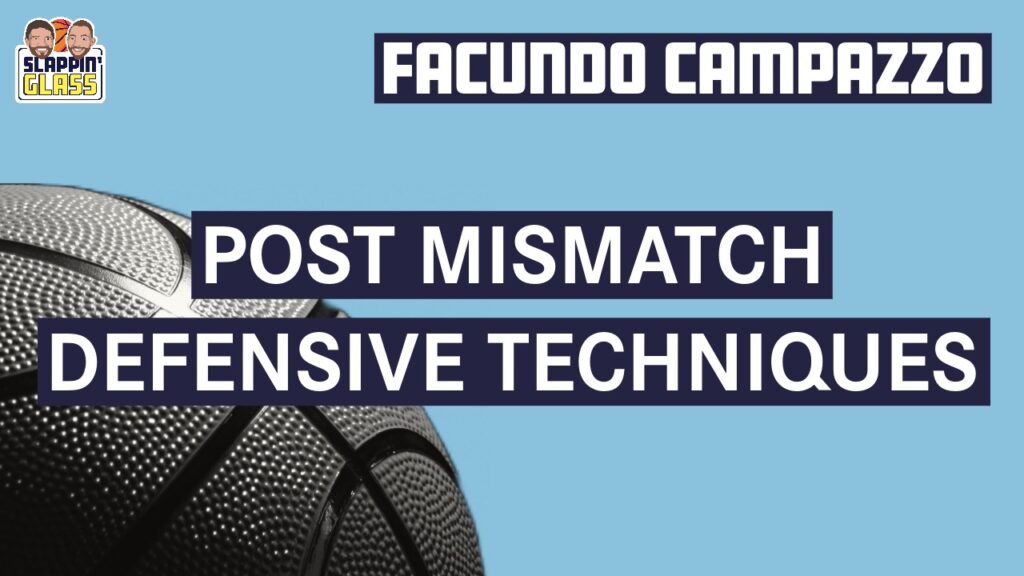With the prevalence of switching in today’s game, we are always interested in studying teams or players that are effective in doing so. While various team tactics to either protect (See Coach Jasikevicius’ “Switch & Shrink”🔒) or solve mismatches (See “Hitting” 🔒the ballhandler) are great to evaluate, so too are individual techniques of how some of the top players in the game, on both sides of the size spectrum, employ defensive techniques to win or contain their mismatches. These techniques help disadvantaged defenders stay on the court and prevent their team from having to further scramble to protect them. For instance, a few months back, we looked at how traditional, slower-footed 5-Men are working with their footwork and stance to force ballhandlers to attack one direction, maximizing their size and protecting their speed disadvantage when defending on the perimeter…
In today’s breakdown, we shift our focus and look at how diminutive guards, like Facundo Campazzo, can effectively defend against bigs in the post.
Arm Bar Swipes
Following our conversation with Serbian Professional Coach, Marko Barac, discussing how guards can navigate through screens and gain an advantage in the physical battle by targeting the hips of the bigger screener, we began looking into other “winnable” battles for a “small” when matched up against a bigger body. Here is where “post mismatch defense” comes into play.
The first thing that stood out when studying Campazzo is how low and wide he gets when defending the post, creating a low center of gravity and ensuring all his force is directed at the hips of the post player. This makes it difficult for the post to use brute force in their back down to the rim. We were hard-pressed to find any clips of Campazzo being “bulldozed” underneath the basket.
If the first battle is preventing the post player from driving him under the basket, the next battle to be won is attacking the ball while it is still close to the ground. If the offensive big cannot get to the rim for an easy lay-up, drop step, etc, their next realization will be that they can still turn and shoot over Campazzo. This is where we begin to notice the importance of Campazzo’s hand placement, prepared with his free hand to swipe at the ball when the post player gathers for the turn around. Side note: We were also hard-pressed to find a lot clips with bigs going to their jump hooks from distance either 🤔.
Zooming In: Like a snake coiled to attack 🐍, when Dante Exum turns middle to raise up, rather than attempting to contest the shot where the size advantage is obviously not in his favor, Campazzo looks to attack the ball when it is at its lowest point and brought to the middle of the shooter’s body.
For post player’s capable of turning over both shoulders or preference to shoot over the left shoulder, Campazzo is quick to change his hand positioning on the spin.
Zooming In: Most players often raise the ball up through the middle of their bodies when executing a turn-around shot. Consequently, the ball will be momentarily exposed and vulnerable to swipes and steals. Once the ball gets to the shooter’s head, Campazzo will have very little influence in deterring the attempt.
Pulling the Chair
A tried and true strategy that has stood the test of time is leveraging the post player’s own momentum against them by “pulling the chair” out from under them on backdowns. This tactic is especially beneficial when opponents attempt to back down from the mid-post or perimeter and require several “bumps” in an effort to gain post position.
Campazzo is exceptional in his timing of “pulling the chair”, which is right as his opponent is re-loading to go back in for another contact.
Zooming In: This is where Campazzo’s low and wide stance pays off again, as post players cannot easily move him and attempt to hit him multiple times to gain a better position. Anticipating when to “pull the chair” is better served when Campazzo can force the opponent to attempt a 2nd or 3rd bump.
Campazzo’s understanding of the battles he must win and which ones better serve his physical attributes puts him in a better position to defend the post and be less reliant on doubles or tactical schemes to protect him. Of course, there are instances when he may pick up fouls or miss on the reach, but these are calculated risks that are more impactful than attempting to wall up or contest, in which case it becomes more a matter of whether the post player made or missed, versus whether Campazzo deterred anything.
For plenty more examples on Campazzo’s hand positioning and timing of his swipes view the full breakdown now on SGTV!
